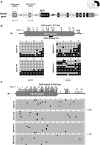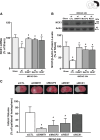Stroke Causes DNA Methylation at Ncx1 Heart Promoter in the Brain Via DNMT1/MeCP2/REST Epigenetic Complex
- PMID: 38456444
- PMCID: PMC11010005
- DOI: 10.1161/JAHA.123.030460
Stroke Causes DNA Methylation at Ncx1 Heart Promoter in the Brain Via DNMT1/MeCP2/REST Epigenetic Complex
Abstract
Background: REST (Repressor-Element 1 [RE1]-silencing transcription factor) inhibits Na+/Ca2+exchanger-1 (Ncx1) transcription in neurons through the binding of RE1 site on brain promoter (Br) after stroke. We identified a new putative RE1 site in Ncx1 heart promoter (Ht) sequence (Ht-RE1) that participates in neuronal Ncx1 transcription. Because REST recruits DNA-methyltransferase-1 (DNMT1) and MeCP2 (methyl-CpG binding protein 2) on different neuronal genes, we investigated the role of this complex in Ncx1 transcriptional regulation after stroke.
Methods and results: Luciferase experiments performed in SH-SY5Y cells demonstrated that Br activity was selectively decreased by REST, whereas Ht activity was reduced by DNMT1, MeCP2, and REST. Notably, site-direct mutagenesis of Ht-RE1 prevented REST-dependent downregulation of Ncx1. Furthermore, in temporoparietal cortex of 8-week-old male wild-type mice (C57BL/6) subjected to transient middle cerebral artery occlusion, DNMT1, MeCP2, and REST binding to Ht promoter was increased, with a consequent DNA promoter hypermethylation. Intracerebroventricular injection of siREST prevented DNMT1/MeCP2 binding to Ht and Ncx1 downregulation, thus causing a reduction in stroke-induced damage. Consistently, in cortical neurons subjected to oxygen and glucose deprivation plus reoxygenation Ncx1 knockdown counteracted neuronal protection induced by the demethylating agent 5-azacytidine. For comparisons between 2 experimental groups, Student's t test was used, whereas for more than 2 experimental groups, 1-way ANOVA was used, followed by Tukey or Newman Keuls. Statistical significance was set at P<0.05.
Conclusions: If the results of this study are confirmed in humans, it could be asserted that DNMT1/MeCP2/REST complex disruption could be a new pharmacological strategy to reduce DNA methylation of Ht in the brain, ameliorating stroke damage.
Keywords: DNA methylation; DNMT1; MeCP2; NCX1; REST; stroke.
Figures







Similar articles
-
Sp3/REST/HDAC1/HDAC2 Complex Represses and Sp1/HIF-1/p300 Complex Activates ncx1 Gene Transcription, in Brain Ischemia and in Ischemic Brain Preconditioning, by Epigenetic Mechanism.J Neurosci. 2015 May 13;35(19):7332-48. doi: 10.1523/JNEUROSCI.2174-14.2015. J Neurosci. 2015. PMID: 25972164 Free PMC article.
-
NCX1 is a new rest target gene: role in cerebral ischemia.Neurobiol Dis. 2013 Feb;50:76-85. doi: 10.1016/j.nbd.2012.10.010. Epub 2012 Oct 13. Neurobiol Dis. 2013. PMID: 23069678
-
MeCP2 deficiency in the brain decreases BDNF levels by REST/CoREST-mediated repression and increases TRKB production.Epigenetics. 2007 Oct-Dec;2(4):214-22. doi: 10.4161/epi.2.4.5212. Epub 2007 Oct 29. Epigenetics. 2007. PMID: 18075316
-
Transcriptional and epigenetic regulation of ncx1 and ncx3 in the brain.Cell Calcium. 2020 May;87:102194. doi: 10.1016/j.ceca.2020.102194. Epub 2020 Mar 7. Cell Calcium. 2020. PMID: 32172011 Review.
-
The epigenetic switches for neural development and psychiatric disorders.J Genet Genomics. 2013 Jul 20;40(7):339-46. doi: 10.1016/j.jgg.2013.04.007. Epub 2013 May 9. J Genet Genomics. 2013. PMID: 23876774 Review.
Cited by
-
Potential therapeutic targets for ischemic stroke in pre-clinical studies: Epigenetic-modifying enzymes DNMT/TET and HAT/HDAC.Front Pharmacol. 2025 Apr 28;16:1571276. doi: 10.3389/fphar.2025.1571276. eCollection 2025. Front Pharmacol. 2025. PMID: 40356977 Free PMC article. Review.
-
TET3-Interacting LncRNA TILR Is Essential for DNA Hydroxymethylation-Mediated Neuroprotection After Ischemic Stroke.Stroke. 2025 Sep;56(9):2748-2760. doi: 10.1161/STROKEAHA.125.052347. Epub 2025 Jul 16. Stroke. 2025. PMID: 40665901
-
DNA methylation and hydroxymethylation dynamics in the aging brain and its impact on ischemic stroke.Neurochem Int. 2025 Sep;188:106007. doi: 10.1016/j.neuint.2025.106007. Epub 2025 Jun 11. Neurochem Int. 2025. PMID: 40513956 Review.
References
-
- Molinaro P, Sirabella R, Pignataro G, Petrozziello T, Secondo A, Boscia F, Vinciguerra A, Cuomo O, Philipson KD, De Felice M, et al. Neuronal NCX1 overexpression induces stroke resistance while knockout induces vulnerability via Akt. J Cereb Blood Flow Metab. 2016;36:1790–1803. doi: 10.1177/0271678X15611913 - DOI - PMC - PubMed
-
- Formisano L, Guida N, Valsecchi V, Cantile M, Cuomo O, Vinciguerra A, Laudati G, Pignataro G, Sirabella R, Di Renzo G, et al. Sp3/REST/HDAC1/HDAC2 complex represses and Sp1/HIF‐1/p300 complex activates ncx1 gene transcription, in brain ischemia and in ischemic brain preconditioning, by epigenetic mechanism. J Neurosci. 2015;35:7332–7348. doi: 10.1523/JNEUROSCI.2174-14.2015 - DOI - PMC - PubMed
MeSH terms
Substances
LinkOut - more resources
Full Text Sources
Medical
Research Materials
Miscellaneous

